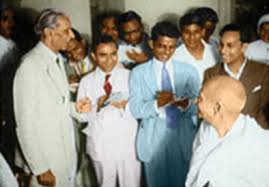Showing posts with label Jinnah Cap. Show all posts
Showing posts with label Jinnah Cap. Show all posts
The Jinnah Cap
One piece of attire has long symbolised Pakistan’s national ideology: the Jinnah cap. Technically known as the Qaraqul cap, for it is made from the fur of the Qaraqul breed of sheep, the hat is typically worn by Central Asian men (presently, Afghan President Hamid Karzai is rarely seen without his). But in Pakistan, the hat has been firmly identified with the Quaid-e-Azam Muhammad Ali Jinnah for decades. This affiliation has ensured that others who sport the cap are understood to be making a political, rather than fashion, statement. Indeed, as Pakistan’s democratic fortunes have waxed and waned over the years, the choice by certain politicians to don the Jinnah cap has revealed much about political aspirations and the public mood.
The Jinnah cap was first initiated into national politics in 1937, when Jinnah sported it at the Lucknow session of the All India Muslim League on October 15. The cap was part of a complete change in Jinnah’s wardrobe; he surrendered his Saville Row suits in favour of a sherwani and Qaraqul cap meant to signify his commitment to the idea of a separate nation for the Muslims of South Asia.
Interestingly, at that point, many regarded the Jinnah cap as an answer to the hand-spun cotton cap which Gandhi and Jawaharlal Nehru used to wear, and which had come to symbolise the Congress Party’s ideals at the time.
Since then, the cap has graced many a brow vying for a successful political, even religious, career in the Land of the Pure. The cap has come to acquire ample political significance and is bought usually by oath-takers as a ritual to achieve the ‘crowning touch.’ In most cases, however, the cap’s symbolism has not proved powerful enough to achieve the degree of leadership success that Jinnah managed.
The Jinnah cap was first initiated into national politics in 1937, when Jinnah sported it at the Lucknow session of the All India Muslim League on October 15. The cap was part of a complete change in Jinnah’s wardrobe; he surrendered his Saville Row suits in favour of a sherwani and Qaraqul cap meant to signify his commitment to the idea of a separate nation for the Muslims of South Asia.
Interestingly, at that point, many regarded the Jinnah cap as an answer to the hand-spun cotton cap which Gandhi and Jawaharlal Nehru used to wear, and which had come to symbolise the Congress Party’s ideals at the time.
Since then, the cap has graced many a brow vying for a successful political, even religious, career in the Land of the Pure. The cap has come to acquire ample political significance and is bought usually by oath-takers as a ritual to achieve the ‘crowning touch.’ In most cases, however, the cap’s symbolism has not proved powerful enough to achieve the degree of leadership success that Jinnah managed.
Subscribe to:
Posts (Atom)
Gandhi and Jinnah - a study in contrasts
An extract from the book that riled India's Bharatiya Janata Party and led to the expulsion of its author Jaswant Singh, one of the foun...

-
Speech on the Inauguration of the Pakistan Constituent Assembly on 14th August, 1947 Your Excellency, I thank His Majesty the King on behalf...
-
Reply to the Civic Address presented by the Quetta Municipality on I5th June, 1948. I thank you for your address of welcome and for the ki...


